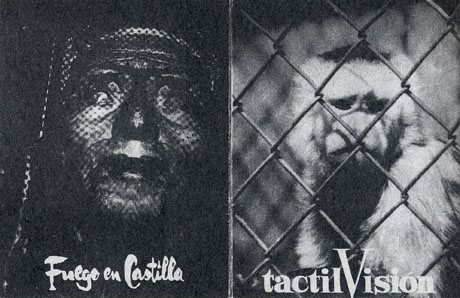''In Spain, every spring death comes and raises the curtains.'' – Federico García Lorca
but death is nothing... more than a word when it is loved – JVdO
Texts that shed light on Fire in Castilla
Marcelino Menéndez Pelayo – ''The poetry of St John of the Cross inspires me with fear to the marrow.''
Federico García Lorca (Impressions and Landscapes, 1918) – ''The saints, romantic heroes of suffering for the love of God and men, did not find their artistic incarnation in Spanish sculpture. All that is needed to demonstrate this is a walk through the rooms of the Museum in Valladolid. Horror! This is profoundly painful to observe the shocking mediocrity of the sculpture. It is the most earthbound art. Its geniuses got no further than the first note of the spiritual scale. They never struck a chord.
''The sculpture is very cold and very unrewarding to the artist. It reproduces, it never creates... It does not pave the way for other men to read the emotions that lead them to the solitary garden of dreams.''
[Comment by José Val del Omar] – ''And I have tried, precisely, to pave the way, programmed, tactile in the most tactile of all the arts, by means of the complementary luminous energy of the tactile sensibility of the spectator.''
Francisco de Cossío (Director of the Museo Nacional de Escultura Religiosa, Valladolid) – ''Berruguete is the genial pyrotechnical genius of the Spanish altarpiece. Painter, sculptor and architect of the religious spectacle under throbbing flames, organ notes, choral hymns, stained glass windows and clouds of incense.
''His figures in genuine and original attitudes of our blood, captured in the instant of greatest mental tension between the flames and the smoke, take on the function of the church and cry out in the most fantastic way.''
Jean Cocteau – ''In Spain everything undulates and blazes. Flamenco dance itself is a flame that the bailaores try to stamp out. In flamenco everything is a coordination of movements with a unitary sense. A coordination of personal attitudes before a common fire that seeks to devour it. Ablaze, the dance is none other than the way of putting out that fire. Stamping on the flames, slapping their thighs, their bodies, where those flames break out.''
Gregorio Marañón – ''Berruguete and El Greco tell us it is true that certain dreams show us poor mortals and the mystics their ecstasy; that is to say that the world is not only full of realities, but also of mysteries.''
Serge Lifar – ''In Berruguete is the germ of an incredible ballet. What hand, what technical numen can animate those burning logs in this divine pantomime.''
Maurice Legendre (founder of the Casa de Velázquez) quoted by Sergei M. Eisenstein – ''The Spanish jondo rhythm and the painting of El Greco have a phenomenal correspondence.''
The filmmaker's intention
In the year 1935, in a cinematographic manifesto I wrote: ''We want to make a cinema that looks to God in framing and pursuing energy.''
Two years ago, in another communication, I confirmed this: ''Spanish thought, which unveiled rises by secret stair and in the dark night attains and delights an instant in Unity, then descends to its earthly dream with only love for exercise.''
Now, the filmmaker thinks that the world is close and ready for some one to rouse it from its sensuous, realist dream ''of fleeting lights'' and, by way of a far from supernatural channel, immerse it in the forebodings of the spectacle of the invasion of this Vale of Differences by means of the Fire that restores us to Unity.

^ | | | Filmespaña, supplement no. 3, 1961 |
| Texts that shed light on Fire in Castilla |
| programme notes |
|